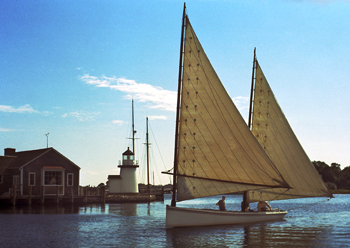
The New Haven Oyster Tonging Sharpie, built circa 1890 by Lester Rowe of Fair Haven, Connecticut, for Sherman Chipman of Fair Haven, evolved from the early dugouts and skiffs that were used for oystering before the 1820s. Sharpies originated on the Connecticut shore of Long Island Sound as a refinement responsive to both changing needs and advancing technology. Tongers had to travel farther away for oysters as the beds near home became exhausted and they needed better sailing boats. Inexpensive, shallow, and easy to handle, the larger sharpies rigged as cat ketches proved popular not only with Connecticut tongers, but with the oystermen in the Chesapeake and southern Atlantic coast as well.
The sharpies were shoal draft, flat bottom, centerboarders that were fast sailers and could be easily sculled when not under sail. At the height of their development, the sharpie had a two-masted rig, such as the one found in the Museum’s collection. The round stern and balanced rudder is very typical, although the square stern was common. The centerboard was often a piece of oiler iron pierced with about three rows of large circular holes at the top.
When working the oyster beds in well-protected harbors and bays, the sharpie was anchored by poles aft and forward ends, and was steadied with a bushel basket hanging off the stern. The tonger stood on the side deck working with 12- to 15-foot tongs–scissor style–to gather a load and drop it into the boat. Up to 100 bushels of oysters could be tonged by one man in one day. A 35′ sharpie worked by a two-man team could carry up to 175 bushels of natural growth oysters.
This boat is presently under restoration in the Preservation Shipyard.


